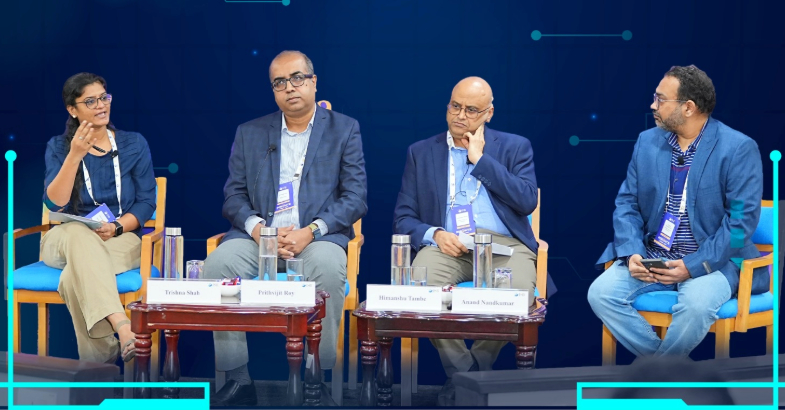
In an era where terms like ‘ChatGPT,’ ‘Gemini,’ ‘driverless cars,’ and ‘automated everything’ dominate both headlines and boardroom discussions, the pervasive question remains: Is Artificial Intelligence (AI) the transformative force akin to electricity or the internet – or are we merely witnessing another iteration of a cyclical tech bubble?
SRITNE, ISB recently convened a panel of distinguished thought leaders—Trishna Shah, Principal PM Lead at Microsoft; Prithvijit Roy, Lead & MD (Data & AI) at Accenture and Himanshu Tambe, Clinical Professor of Strategy at ISB – to dissect this pressing question. Their insightful exchange offers much-needed clarity amidst the fervent optimism and underlying apprehension surrounding AI’s future.
Moderated by Professor Anand Nandkumar, the discussion also dissected AI’s promise, pitfalls, and pragmatic challenges. Here’s what emerged.
AI’s Promise: General-Purpose Technology or Overhyped Tool?
AI’s proponents argue it is a general-purpose technology (GPT) – a foundational innovation like electricity that reshapes economies. Skeptics, however, warn of inflated expectations.
Trishna Shah offered a compelling case for AI’s transformative capacity:
“AI is absolutely a general-purpose technology. It’s been embedded in everyday tools—spam filters, recommendation engines—for years. What’s changed today is accessibility. Thanks to better data, computational power, and user-friendly interfaces, we’re seeing a democratization of AI use cases.”
Prithvijit Roy expanded on this, highlighting how generative AI has brought the technology into mainstream consciousness:
“What generative AI has done is consumerize AI. It’s become part of everyday life. The potential to reshape industries is undeniable—but we’re still scratching the surface.”
Himanshu Tambe, however, struck a more cautious note, emphasizing the work still needed:
“AI has the potential to become a GPT, but it’s not there yet. The barriers are not just technical—they are infrastructural, organizational, and economic. Data is the biggest bottleneck.”
The Data Dilemma: AI’s Most Persistent Challenge
While AI models grow increasingly sophisticated, their effectiveness remains heavily dependent on high-quality, accessible data—a hurdle the panelists agreed is far from resolved.
Trishna Shah pointed to the gap between technological capability and real-world applicability:
“Data infrastructure has improved, but data sanctity—clean, relevant, usable data—is still a major concern. Especially in enterprise applications, like building reliable chatbots or healthcare tools.”
Prithvijit Roy noted the expanding definition of data—and the challenges that come with it:
“Everything is data now—images, audio, video. But, collecting and organizing it at scale is expensive. We are trying to solve these problems with AI itself—AI cleaning data for AI.”
Himanshu Tambe provided a sobering real-world example of institutional barriers:
“In one project on domestic abuse, we could not even begin modelling because ministries would not share data. Unless institutions evolve, data will remain a constraint.”
The Productivity Paradox: Why AI’s Impact Isn’t More Visible
Despite AI’s rapid advancements, its measurable impact on productivity and economic growth remains inconsistent – a phenomenon the panelists unpacked.
Prithvijit Roy observed that many companies remain stuck in experimentation mode:
“Most enterprises are still piloting AI. There’s a joke that some companies have more AI pilots than Air India. But slowly, we are seeing infusion into sales, business intelligence, anomaly detection, and more.”
Trishna Shah cited tangible benefits in healthcare:
“AI is already streamlining practitioner workflows, improving diagnostics, and personalizing wellness. Nuance, for instance, automates note-taking for doctors, freeing up time for patient care. But much of this is under the hood—it’s not always visible to users.”
Himanshu Tambe, however, warned of broader socioeconomic disruptions:
“There’s downward wage pressure on high-skilled jobs and upward pressure on routine roles due to automation. The net effect? A reshaped middle class and compressed wage structures. Inequality might look different in an AI-powered world.”
The Road Ahead: How to Realize AI’s Full Potential
The panelists concluded with key recommendations for ensuring AI’s responsible and effective adoption:
- Regulatory Frameworks – Guardrails to balance innovation with ethical considerations.
- Data Infrastructure – Policies to improve sharing while maintaining privacy and security.
- Cultural Shifts – Organizations must view AI as a tool for augmentation, not just automation.
The Concluding Thoughts
AI is neither a silver bullet nor a fleeting trend – it is a powerful, evolving tool whose ultimate impact depends on how we choose to develop and deploy it. For business leaders, policymakers, and academics, the challenge is clear: Navigate the hype, address the bottlenecks, and steer AI toward meaningful, sustainable progress.
The insights from this SRITNE discussion offer a roadmap for doing just that.
To explore the complete discussion and gain deeper insights from these industry leaders, read the original article and watch the full video here: https://www.isb.edu/faculty-and-research/srini-raju-centre-for-it-and-the-networked-economy/artificial-intelligence-sorting-hype-from-reality

